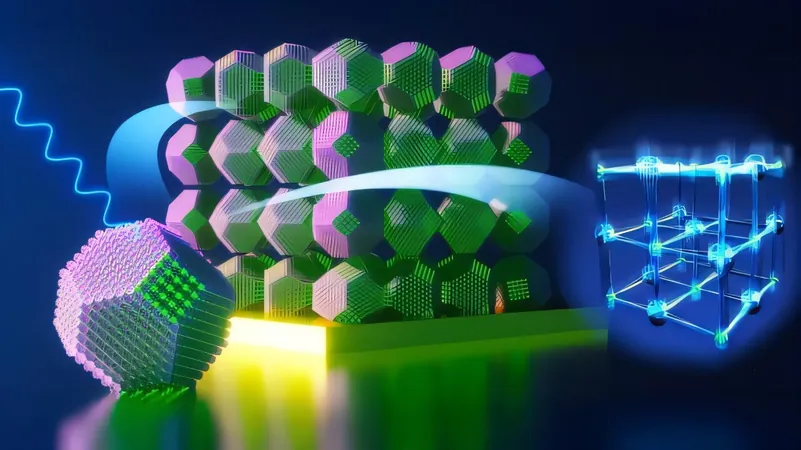
Revolutionary Breakthrough: Light Can Transform Tiny Crystals into Tailored Quantum Materials!
2025-03-24
Author: Daniel
Introduction
Imagine constructing a magnificent Lego tower with perfect precision, where each block symbolizes an atom in a quantum dot, a minuscule crystal with extraordinary qualities. Similar to how a bump can change the arrangement of Lego blocks, researchers have discovered a groundbreaking method to manipulate the atoms in these tiny structures, altering their symmetry and, in turn, their properties.
The Research at Argonne National Laboratory
In an innovative study conducted at the U.S. Department of Energy's Argonne National Laboratory, scientists have learned how to use light to intentionally create or restore symmetry in quantum dots. These semiconductor materials, including lead sulfide, are famed for their remarkable optical and electronic behaviors, largely due to their nanoscale size. This evolution in research opens the door to a myriad of potential applications across electronics, medical imaging, and beyond.
Understanding Lead Sulfide Structure
Typically, lead sulfide forms a cubic structure—think of it as a perfectly organized grid of alternating red and blue Lego blocks. However, groundbreaking previous findings revealed that the arrangement of lead atoms showed deviations from this expected perfection, hinting at a less symmetrical state that could unlock new material characteristics. "When symmetries change, it can feel like you're working with a brand-new material," noted physicist Richard Schaller from Argonne, emphasizing the excitement within the scientific community to discover methods to produce unusual states of matter that are unattainable under normal conditions.
Utilization of Laser and X-ray Technologies
Utilizing cutting-edge laser and X-ray technologies, the Argonne research team investigated how the architecture of lead sulfide quantum dots responds to light exposure. They employed sophisticated tools like the Megaelectronvolt Ultrafast Electron Diffraction (MeV-UED) at the SLAC National Accelerator Laboratory to observe changes in these quantum dots within unimaginably brief intervals, as short as a trillionth of a second. Concurrently, at Argonne's Advanced Photon Source (APS), scientists executed rapid total X-ray scattering experiments to capture transient structural changes on a billionth-of-a-second timescale, leveraging a state-of-the-art facility that serves high-energy X-ray beams up to 500 times brighter than before.
Remarkable Findings of the Study
Win a technology lottery? These organizations' facilities have been instrumental in extending our understanding of symmetry control at the quantum level. The research team found something remarkable: upon exposure to powerful laser light bursts, the quantum dots transitioned from a jumble of atoms to a far more ordered and symmetric arrangement. "Light pulses excite electrons, prompting the atoms to reposition towards a centered state," clarified Burak Guzelturk, a physicist at the APS.
Impact on Electronic Properties
This leap into symmetry restoration profoundly impacts the electronic properties of the quantum dots. The researchers recorded a significant decrease in bandgap energy—an essential factor determining how well semiconductors conduct electricity and respond to electric fields.
Exploring Size and Chemistry Variations
Moreover, the study explored how variations in quantum dot sizes and surface chemistry impacted symmetry shifts, allowing researchers to finely tune the materials' optical and electronic behaviors. "We often take for granted that crystal structure remains unchanged, but these experiments provide compelling evidence that they're dynamic when light is absorbed," Schaller remarked.
Conclusion and Future Prospects
This pioneering research marks a critical advancement in nanoscience and technology. The ability to manipulate the symmetry of quantum dots with just bursts of light means that scientists can create materials with tailored features that cater to specific needs. Much like how Lego blocks can be transformed into an endless array of configurations, this research enables the "construction" of quantum dots with desired properties, setting the stage for future technological innovations.
Stay tuned for more updates as scientists continue to unveil the incredible potential of quantum materials, which could redefine electronics, telecommunications, and much more!


 Brasil (PT)
Brasil (PT)
 Canada (EN)
Canada (EN)
 Chile (ES)
Chile (ES)
 Česko (CS)
Česko (CS)
 대한민국 (KO)
대한민국 (KO)
 España (ES)
España (ES)
 France (FR)
France (FR)
 Hong Kong (EN)
Hong Kong (EN)
 Italia (IT)
Italia (IT)
 日本 (JA)
日本 (JA)
 Magyarország (HU)
Magyarország (HU)
 Norge (NO)
Norge (NO)
 Polska (PL)
Polska (PL)
 Schweiz (DE)
Schweiz (DE)
 Singapore (EN)
Singapore (EN)
 Sverige (SV)
Sverige (SV)
 Suomi (FI)
Suomi (FI)
 Türkiye (TR)
Türkiye (TR)
 الإمارات العربية المتحدة (AR)
الإمارات العربية المتحدة (AR)